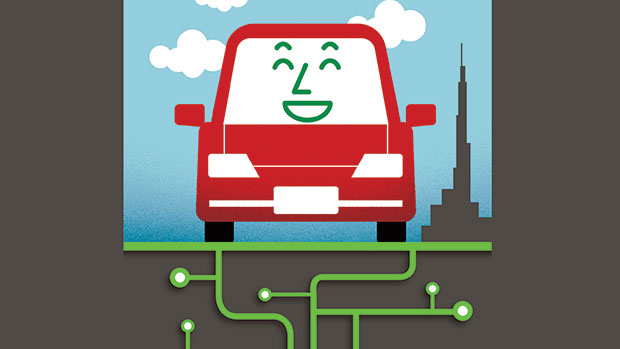
Both the Dubai Smart City Strategy and UAE National Innovation Strategy include transport. Public transport is often the focus of city planners, but cars are getting smarter all the time, creating new streams of data and information to help drivers and businesses — and the broader smart city.
The UAE automobile sector witnessed record sales in 2013 and is expected to remain one of the fastest growing markets in the world for both retail and fleet sales, driven by population growth. With over 350,000 new vehicles on the UAE roads every year, wouldn’t it be better if they were smarter?
The number of ‘connected cars’ — vehicles augmented with internet-connected intelligent systems and services — is increasing rapidly: Not only are self-driving cars set to become legal in the UK from 2015 (as they are already in parts of the US), but analysts expect the market to be worth €39 billion (Dh179.5 billion) by 2018.
Today’s connected vehicles combine increasingly powerful embedded or on-board intelligence with an internet connection. This puts applications such as in-car telematics — the long-distance transmission of computerised information from your car to service providers — into the mainstream.
In the EU, Russia and Brazil, recent laws demand new vehicles must carry an embedded SIM and wireless modem from 2015. This ‘eCall’ legislation is intended to enable the vehicle to request help if involved in an accident or stolen, but the connectivity is an opportunity for service providers, developers, and your enterprise.
Consumer-facing solutions such as Apple CarPlay and Google Auto use the intelligence and connectivity inside a smartphone together with a vehicle’s own proprietary systems. Most automobile manufacturers have plans to make future vehicles compatible with both Apple and Google in-car systems; some analysts believe such smartphone integrated systems will be more popular with automakers than tethered (embedded) solutions, because of technical and policy hurdles related to connecting the handset with the in-car computer.
Europe’s new eCall legislation comes into effect in 2015, immediately turning the region into the world’s largest connected car market.
But there are plenty of smartphone-based or connected third-party device systems you can use right now. This means you can access apps and location services to help you avoid congestion or solutions to monitor and improve your driving patterns.
As in-car sensors improve they will develop the ability to communicate with other nearby vehicles, sharing warnings of traffic accidents or alerting drivers if vehicles are driving unsafely close together.
Such solutions are already in development by firms like NXPand car firms. These systems will enable connected cars to augment your driving experience to improve safety.
The next step is driverless cars: Google, Tesla, Nissan and several other carmakers are all working on self-driving vehicles which will drastically reduce driver error and improve safety as they hit European roads starting next year.
Insurers already offer ‘Pay How you Drive’ policies in which drivers agree to carry connected sensors in their vehicles to monitor their driving. Fleet management systems such as Teletrac’s award-winning GPS Fleet Director solution also monitor driving habits, watching for harsh braking, speeding and stop sign violations.
Access to this data lets insurers charge good drivers less. Ptolemus research claims these ‘black boxes’ can reduce the number of accident claims by 30 per cent while Teletrac claims they cut insurance premiums by 30 per cent. There are already around 500,000 such policies in the UK.
As embedded connectivity becomes mandatory with eCall, such driver analysis systems will become standard fitting in future vehicles.
Manufacturers are developing remote diagnosis and monitoring solutions for connected cars. These systems rely on a car’s built-in computer systems to monitor the car condition, brake and engine health data which they share with maintenance centres and/or drivers so problems can be addressed fast. Drivers enjoy the convenience while car manufacturers get to offer extra features and services in their vehicles.
Manufacturers already use these tools to help them assess warranty claims while accident/emergency investigators are using these for crash scene evidence collection. There is also potential for insurance firms to acquire this data from connected vehicles, which should reduce premiums for maintenance-conscious drivers. The opportunity to cut costs, offer services and open new income streams means every car manufacturer is developing its own remote diagnosis solution.
Business users will benefit from increased fuel efficiency, helping them meet emissions reduction targets.
GreenRoad has developed a reward system that praises safe driving practices, based on criteria such as speed, vehicle handling and braking intensity. This ‘game-ification’ of good driving seems to nurture good habits by giving instant feedback so that drivers can correct bad habits and improve fuel efficiency — they claim customers see crash-related costs fall by 70 per cent and fuel consumption fall 6 to 15 per cent, reducing carbon dioxide emissions.
When it comes to security, car thieves are technologically literate and are figuring out how to break into vehicles fitted with electronic safeguards. AVG claims almost half of 89,000 vehicles in London that were reported broken into or stolen were electronically hacked.
There is still a long road ahead to realise the promise of the connected car but the pace of smart city development puts the UAE in the fast lane.
— The writer is Managing Director, Orange Business Services, and Director of the Board at Orange Business Arabia.












